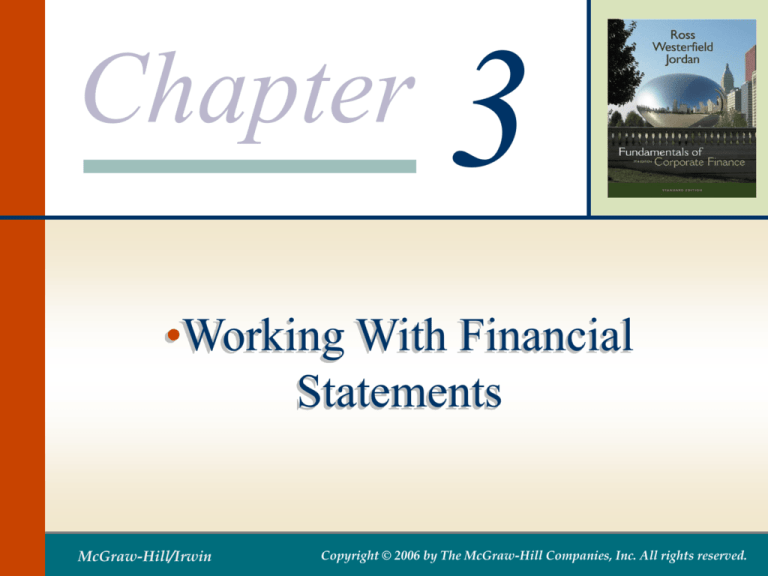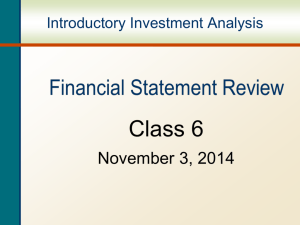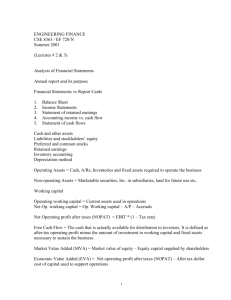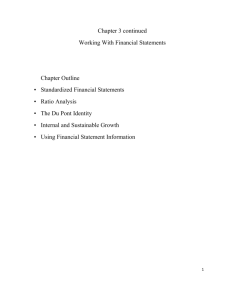
Chapter
3
•Working With Financial
Statements
McGraw-Hill/Irwin
Copyright © 2006 by The McGraw-Hill Companies, Inc. All rights reserved.
Key Concepts and Skills
• Understand sources and uses of cash and the
Statement of Cash Flows
• Know how to standardize financial statements for
comparison purposes
• Know how to compute and interpret important
financial ratios
• Be able to compute and interpret the DuPont
Identity
• Understand the problems and pitfalls in financial
statement analysis
3-1
Chapter Outline
• Cash Flow and Financial Statements: A
Closer Look
• Standardized Financial Statements
• Ratio Analysis
• The DuPont Identity
• Using Financial Statement Information
3-2
Sample Balance Sheet
Numbers in millions
2003
2002
2003
2002
Cash
696
58 A/P
307
303
A/R
956
992 N/P
26
119
Inventory
301
361 Other CL
1,662
1,353
Other CA
303
264 Total CL
1,995
1,775
Total CA
2,256
1,675 LT Debt
843
1,091
Net FA
3,138
3,358 C/S
2,556
2,167
Total
Assets
5,394
5,033 Total Liab.
& Equity
5,394
5,033
3-3
Sample Income Statement
Numbers in millions, except EPS & DPS
Revenues
5,000
Cost of Goods Sold
2,006
Expenses
1,740
Depreciation
116
EBIT
1,138
Interest Expense
7
Taxable Income
Taxes
1,131
442
Net Income
689
EPS
3.61
Dividends per share
1.08
3-4
Sources and Uses
• Sources
• Cash inflow – occurs when we “sell” something
• Decrease in asset account (Sample B/S)
• Accounts receivable, inventory, and net fixed assets
• Increase in liability or equity account
• Accounts payable, other current liabilities, and common stock
• Uses
• Cash outflow – occurs when we “buy” something
• Increase in asset account
• Cash and other current assets
• Decrease in liability or equity account
• Notes payable and long-term debt
3-5
Statement of Cash Flows
• Statement that summarizes the sources
and uses of cash
• Changes divided into three major
categories
• Operating Activity – includes net income and
changes in most current accounts
• Investment Activity – includes changes in fixed
assets
• Financing Activity – includes changes in notes
payable, long-term debt and equity accounts
as well as dividends
3-6
Sample Statement of Cash
Flows
Numbers in millions
Cash, beginning of year
58
Operating Activity
Financing Activity
Decrease in Notes Payable
Net Income
689
Decrease in LT Debt
Plus: Depreciation
116
Decrease in C/S (minus RE)
Decrease in A/R
36
Decrease in Inventory
60
Increase in A/P
Increase in Other CL
Less: Increase in CA
Net Cash from Operations
4
309
Dividends Paid
Net Cash from Financing
-93
-248
-94
-206
-641
Net Increase in Cash
638
Cash End of Year
696
-39
1,175
Investment Activity
Sale of Fixed Assets
Net Cash from Investments
104
104
3-7
Standardized Financial
Statements
• Common-Size Balance Sheets
• Compute all accounts as a percent of total assets
• Common-Size Income Statements
• Compute all line items as a percent of sales
• Standardized statements make it easier to
compare financial information, particularly as the
company grows
• They are also useful for comparing companies of
different sizes, particularly within the same
industry
3-8
Ratio Analysis
• Ratios also allow for better comparison
through time or between companies
• As we look at each ratio, ask yourself what
the ratio is trying to measure and why is
that information is important
• Ratios are used both internally and
externally
3-9
Categories of Financial Ratios
• Short-term solvency or liquidity ratios
• Long-term solvency or financial leverage
ratios
• Asset management or turnover ratios
• Profitability ratios
• Market value ratios
3-10
Computing Liquidity Ratios
• Current Ratio = CA / CL
• 2256 / 1995 = 1.13 times
• Quick Ratio = (CA – Inventory) / CL
• (2256 – 1995) / 1995 = .1308 times
• Cash Ratio = Cash / CL
• 696 / 1995 = .35 times
• NWC to Total Assets = NWC / TA
• (2256 – 1995) / 5394 = .05
• Interval Measure = CA / average daily operating
costs
• 2256 / ((2006 + 1740)/365) = 219.8 days
3-11
Computing Long-term Solvency
Ratios
• Total Debt Ratio = (TA – TE) / TA
• (5394 – 2556) / 5394 = 52.61%
• Debt/Equity = TD / TE
• (5394 – 2556) / 2556 = 1.11 times
• Equity Multiplier = TA / TE = 1 + D/E
• 1 + 1.11 = 2.11
• Long-term debt ratio = LTD / (LTD + TE)
• 843 / (843 + 2556) = 24.80%
3-12
Computing Coverage Ratios
• Times Interest Earned = EBIT / Interest
• 1138 / 7 = 162.57 times
• Cash Coverage = (EBIT + Depreciation) /
Interest
• (1138 + 116) / 7 = 179.14 times
3-13
Computing Inventory Ratios
• Inventory Turnover = Cost of Goods Sold /
Inventory
• 2006 / 301 = 6.66 times
• Days’ Sales in Inventory = 365 / Inventory
Turnover
• 365 / 6.66 = 55 days
3-14
Computing Receivables Ratios
• Receivables Turnover = Sales / Accounts
Receivable
• 5000 / 956 = 5.23 times
• Days’ Sales in Receivables = 365 /
Receivables Turnover
• 365 / 5.23 = 70 days
3-15
Computing Total Asset Turnover
• Total Asset Turnover = Sales / Total Assets
• 5000 / 5394 = .93
• It is not unusual for TAT < 1, especially if a firm
has a large amount of fixed assets
• NWC Turnover = Sales / NWC
• 5000 / (2256 – 1995) = 19.16 times
• Fixed Asset Turnover = Sales / NFA
• 5000 / 3138 = 1.59 times
3-16
Computing Profitability
Measures
• Profit Margin = Net Income / Sales
• 689 / 5000 = 13.78%
• Return on Assets (ROA) = Net Income /
Total Assets
• 689 / 5394 = 12.77%
• Return on Equity (ROE) = Net Income /
Total Equity
• 689 / 2556 = 26.96%
3-17
Computing Market Value
Measures
• Market Price = $87.65 per share
• Shares outstanding = 190.9 million
• PE Ratio = Price per share / Earnings per
share
• 87.65 / 3.61 = 24.28 times
• Market-to-book ratio = market value per
share / book value per share
• 87.65 / (2556 / 190.9) = 6.56 times
3-18
Deriving the DuPont Identity
• ROE = NI / TE
• Multiply by 1 and then rearrange
• ROE = (NI / TE) (TA / TA)
• ROE = (NI / TA) (TA / TE) = ROA * EM
• Multiply by 1 again and then rearrange
• ROE = (NI / TA) (TA / TE) (Sales / Sales)
• ROE = (NI / Sales) (Sales / TA) (TA / TE)
• ROE = PM * TAT * EM
3-19
Using the DuPont Identity
• ROE = PM * TAT * EM
• Profit margin is a measure of the firm’s
operating efficiency – how well does it control
costs
• Total asset turnover is a measure of the firm’s
asset use efficiency – how well does it
manage its assets
• Equity multiplier is a measure of the firm’s
financial leverage
3-20
Expanded DuPont Analysis –
Aeropostale Data
• Balance Sheet Data
•
•
•
•
•
Cash = 138,356
Inventory = 61,807
Other CA = 12,284
Fixed Assets = 94,601
EM = 1.654
• Computations
• TA = 307,048
• TAT = 2.393
• Income Statement Data
•
•
•
•
•
Sales = 734,868
COGS = 505,152
SG&A = 141,520
Interest = (760)
Taxes = 34,702
• Computations
•
•
•
•
NI = 54,254
PM = 7.383%
ROA = 17.668%
ROE = 29.223%
3-21
Aeropostale Extended DuPont
Chart
ROE = 29.223%
ROA = 17.668%
Total Costs = - 680,614
EM = 1.654
x
PM = 7.383%
NI = 54,254
x
+
Sales = 734,868
Sales = 734,868
TAT = 2.393
Sales = 734,868
TA = 307,048
Fixed Assets = 94,601
COGS = - 505,152
SG&A = - 141,520
Cash = 138,356
Interest = - (760)
Taxes = - 34,702
Other CA = 12,284
+
Current Assets = 212,447
Inventory = 61,807
3-22
Why Evaluate Financial
Statements?
• Internal uses
• Performance evaluation – compensation and
comparison between divisions
• Planning for the future – guide in estimating
future cash flows
• External uses
•
•
•
•
Creditors
Suppliers
Customers
Stockholders
3-23
Benchmarking
• Ratios are not very helpful by themselves;
they need to be compared to something
• Time-Trend Analysis
• Used to see how the firm’s performance is
changing through time
• Internal and external uses
• Peer Group Analysis
• Compare to similar companies or within
industries
• SIC and NAICS codes
3-24
Real World Example - I
• Ratios are figured using financial data from
the 2003 Annual Report for Home Depot
• Compare the ratios to the industry ratios in
Table 3.12 in the book
• Home Depot’s fiscal year ends Feb. 1
• Be sure to note how the ratios are
computed in the table so that you can
compute comparable numbers.
• Home Depot sales = $64,816 MM
3-25
Real World Example - II
• Liquidity ratios
• Current ratio = 1.40x; Industry = 1.8x
• Quick ratio = .45x; Industry = .5x
• Long-term solvency ratio
• Debt/Equity ratio (Debt / Worth) = .54x;
Industry = 2.2x.
• Coverage ratio
• Times Interest Earned = 2282x; Industry =
3.2x
3-26
Real World Example - III
• Asset management ratios:
• Inventory turnover = 4.9x; Industry = 3.5x
• Receivables turnover = 59.1x (6 days); Industry =
24.5x (15 days)
• Total asset turnover = 1.9x; Industry = 2.3x
• Profitability ratios
• Profit margin before taxes = 10.6%; Industry =
2.7%
• ROA (profit before taxes / total assets) = 19.9%;
Industry = 4.9%
• ROE = (profit before taxes / tangible net worth) =
34.6%; Industry = 23.7%
3-27
Potential Problems
• There is no underlying theory, so there is no way
to know which ratios are most relevant
• Benchmarking is difficult for diversified firms
• Globalization and international competition
makes comparison more difficult because of
differences in accounting regulations
• Varying accounting procedures, i.e. FIFO vs.
LIFO
• Different fiscal years
• Extraordinary events
3-28
Work the Web Example
• The Internet makes ratio analysis much
easier than it has been in the past
• Click on the web surfer to go to
www.investor.reuters.com
• Choose a company and enter its ticker symbol
• Click on Ratios and then Financial Condition
and see what information is available
3-29
Quick Quiz
• What is the Statement of Cash Flows and how
do you determine sources and uses of cash?
• How do you standardize balance sheets and
income statements and why is standardization
useful?
• What are the major categories of ratios and how
do you compute specific ratios within each
category?
• What are some of the problems associated with
financial statement analysis?
3-30
Chapter
3
•End of Chapter
McGraw-Hill/Irwin
Copyright © 2006 by The McGraw-Hill Companies, Inc. All rights reserved.









